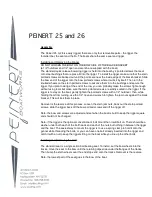
2-8
343 Owner’s Manual
Section 2
Performance Yacht
1 – Recharge
2 – Overcharge
Be sure to:
• Use caution and do not smoke when refueling.
• Verify that fuel does not leak.
• Use only marine approved equipment on your
boat.
Flooding/Swamping
Improper loading, handling, water conditions,
weather and anchoring are the most common
causes of flooding. Insist on a safe, stable load. Do
not operate the boat exceeding your ability to
maneuver it. Use extreme caution in hazardous
weather and rough water conditions. Anchor from
the bow when using one anchor.
Collisions/Leaks
If a collision occurs, immediately account for all
passengers. Assess the hull for damage and
activate the bilge pumps to reduce any water
intake. Try to operate the boat to keep the damaged
area above water. If necessary, call or signal for
assistance. If a leak is discovered, immediately
determine the cause. A collision with an underwater
object could cause the hull to develop a leak. A
loose fitting or hose clamp on a piece of equipment
could cause a leak. Try to repair the leak if possible.
If a leak is threatening the safety of you and your
passengers, call or signal for assistance.
Grounding
In the event you run aground, assess the situation
before proceeding. Immediately stop any water
from entering the boat. Inspect the propulsion
unit(s), steering and control systems, and the hull
for damage. Maneuver the boat to safe water only if
the hull and all operating systems are in
satisfactory operating condition. Otherwise, call or
signal for assistance.
Storms
Take common sense precautions if you are forced
to operate your boat in stormy conditions.
• Wear personal flotation devices (PFDs).
• Stow gear below deck and batten down
equipment on deck.
• Reduce speed and head for a safe place that
you can easily reach.
• If you lose power, keep the boat headed into
the waves by using the anchor.
Water Rescue (Man Overboard)
Immediately react to a person that has fallen
overboard. Keep the victim constantly in your sight.
Safely return to the victim as soon as possible.
Throw the person a PFD. Turn the engines off and
help the person into the boat.
Medical Emergency
Be prepared in the event of an emergency. Know
how to use your first aid kit. Be aware of any special
medical conditions of your passengers.
Drowning
React to a drowning victim the same as described
in Water Rescue. Handle the victim with care. They
could be injured. If necessary, resuscitate the
victim. Immediately signal for help and keep the
victim warm.
Operation Failure
If you experience a propulsion, steering or control
failure, immediately turn off the engines. Release
the anchor to prevent drifting. Try to determine the
failure and repair, if possible. Otherwise, call or
signal for assistance.
KC-0083C
2
1
COB_343_OM_forWeb.book Page 8 Monday, June 12, 2006 10:20 AM














































